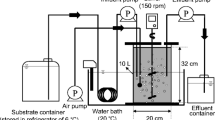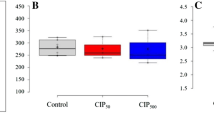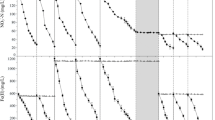Abstract
Per- and polyfluoroalkyl substances (PFASs) have received increasing attention due to their widespread presence in diverse environments including wastewater treatment plants (WWTPs) and their potential adverse health effects. Perfluorooctanoic acid (PFOA) is one of the most detected forms of PFASs in WWTPs. However, there is still a paucity of knowledge about the effect of PFASs on microorganisms of the key component of WWTP, activated sludge. In this study, lab-scale microcosm experiments were established to evaluate the influences of PFOA on activated sludge microbes under aerobic and anaerobic conditions. The diversity, structure, and microbe-microbe interaction of microbial community were determined by 16S rRNA gene amplicon sequencing and co-occurrence network analysis. After 90 days of exposure to PFOA, activated sludge microbial richness decreased under both aerobic and anaerobic conditions. Specifically, under aerobic condition, Rhodopseudomonas (mean relative abundance 3.6%), Flavobacterium (2.4%), and Ignavibacterium (6.6%) were enriched in PFOA-spiked activated sludge compared with that in the unspiked sludge (2.6%, 0.1%, and 1.9%, respectively). By contrast, after 90 days of exposure to PFOA, Eubacterium (2.1%), Hyphomicrobium (1.8%), and Methyloversatilis (1.2%) were enriched under anaerobic condition, and more abundant than that in the control sludge (0.4%, 1.5%, and 0.6%, respectively). These genera were the potential PFOA-resistant members. In addition, Azospirillum and Sporomusa were the most connected taxa in PFOA-aerobic and PFOA-anaerobic networks, respectively. Prediction of the functional gene showed that PFOA inhibited some gene expression of sludge microbes, such as transcription, amino acid transport and metabolism, and energy production and conversion. In summary, continued exposure to PFOA induced substantial shifts of the sludge bacterial diversity and composition under both aerobic and anaerobic conditions.






Similar content being viewed by others
Data availability
The nucleic acid reads of 16S rRNA genes in the current study are available in the NCBI database with the project number PRJNA755805.
References
Abunada Z, Alazaiza MY, Bashir MJ (2020) An overview of per-and polyfluoroalkyl substances (PFAS) in the environment: source, fate, risk and regulations. Water 12:3590
Ammam F, Tremblay P-L, Lizak DM, Zhang T (2016) Effect of tungstate on acetate and ethanol production by the electrosynthetic bacterium Sporomusa ovata. Biotechnol Biofuels 9:163
Arias VA, Mallavarapu M, Naidu R (2015) Identification of the source of PFOS and PFOA contamination at a military air base site. Environ Monit Assess 187:8
Arzumanyan VG, Sakharova ZV, Panikov NS, Vshivtsev VS (1997) Growth and nitrogen-fixing activity of the batch culture of Xanthobacter autotrophicus at various concentrations of dissolved oxygen. Microbiology 66:627–630
Babbitt CW, Pacheco A, Lindner AS (2009) Methanol removal efficiency and bacterial diversity of an activated carbon biofilter. Bioresour Technol 100:6207–6216
Balk M, Mehboob F, van Gelder AH, Rijpstra WIC, Damste JSS, Stams AJM (2010) (Per)chlorate reduction by an acetogenic bacterium, Sporomusa sp., isolated from an underground gas storage. Appl Microbiol Biotechnol 88:595–603
Banerjee S, Schlaeppi K, van der Heijden MGA (2018) Keystone taxa as drivers of microbiome structure and functioning. Nat Rev Microbiol 16:567–576
Bao YX, Li BX, Xie SG, Huang J (2018) Vertical profiles of microbial communities in perfluoroalkyl substance-contaminated soils. Ann Microbiol 68:399–408
Bosso L, Cristinzio G (2014) A comprehensive overview of bacteria and fungi used for pentachlorophenol biodegradation. Rev Environ Sci Biotechnol 13:387–427
Chaignaud P, Maucourt B, Weiman M, Alberti A, Kolb S, Cruveiller S, Vuilleumier S, Bringel F (2017) Genomic and transcriptomic analysis of growth-supporting dehalogenation of chlorinated methanes in methylobacterium. Front Microbiol 8:1600
Chan PWY, Yakunin AF, Edwards EA, Pai EF (2011) Mapping the reaction coordinates of enzymatic defluorination. J Am Chem Soc 133:7461–7468
Chen H, Zou M, Zhou Y, Zeng L, Yang X (2020) Monitoring the nitrous oxide emissions and biological nutrient removal from wastewater treatment: impact of perfluorooctanoic acid. J Hazard Mater 402:123469
Choi SK, Kim JH, Park JK, Lee KM, Kim E, Jeon WB (2013) Cytotoxicity and inhibition of intercellular interaction in N2a neurospheroids by perfluorooctanoic acid and perfluorooctanesulfonic acid. Food Chem Toxicol 60:520–529
Coyte KZ, Schluter J, Foster KR (2015) The ecology of the microbiome: Networks, competition, and stability. Science 350:663–666
Erable B, Goubet I, Lamare S, Seltana A, Legoy MD, Maugard T (2005) Nonconventional hydrolytic dehalogenation of 1-chlorobutane by dehydrated bacteria in a continuous solid-gas biofilter. Biotechnol Bioeng 91:304–313
Gao P, Song B, Xu R, Sun X, Lin H, Xu F, Li B, Sun W (2021) Structure and variation of root-associated bacterial communities of Cyperus rotundus L. in the contaminated soils around Pb/Zn mine sites. Environ Sci Pollut Res 28:58523–58535
Godini K, Samarghandi MR, Tahmasebi H, Zarei O, Karimitabar Z, Yarahmadi Z, Arabestani MR (2019) Biochemical and molecular characterization of novel PAH-degrading bacteria isolated from polluted soil and sludge. Pet Sci Technol 37:1763–1769
Grobelak A, Worwag M, Grosser A (2020) Removal of total petroleum hydrocarbons from wastewater and sewage sludge generated in oil separators and evaluation of the process efficiency. Desalination Water Treat 199:205–211
Han F, Li X, Zhang M, Liu Z, Han Y, Li Q, Zhou W (2021) Solid-phase denitrification in high salinity and low-temperature wastewater treatment. Bioresour Technol 341:125801.
Higgins CP, Field JA, Criddle CS, Luthy RG (2005) Quantitative determination of perfluorochemicals in sediments and domestic sludge. Environ Sci Technol 39:3946–3956
Hooper LV, Macpherson AJ (2010) Immune adaptations that maintain homeostasis with the intestinal microbiota. Nat Rev Immunol 10:159–169
Houtz EF, Higgins CP, Field JA, Sedlak DL (2013) Persistence of perfluoroalkyl acid precursors in AFFF-impacted groundwater and soil. Environ Sci Technol 47:8187–8195
Jiang X, Mingchao MA, Jun LI, Anhuai LU, Zhong Z (2008) Bacterial diversity of active sludge in wastewater treatment plant. Earth Sci Front 15:163–168
Kassab G, Halalsheh M, Klapwijk A, Fayyad M, van Lier JB (2010) Sequential anaerobic-aerobic treatment for domestic wastewater - a review. Bioresour Technol 101:3299–3310
Keith RC, John GH (2001) Induction of a stress protein in Eubacterium biforme by the surfactant CTAB. Microb Ecol Health Dis 13:229–233
Kuczynski J, Stombaugh J, Walters WA, González A, Caporaso JG, Knight R (2011) Using QIIME to analyze 16S rRNA gene sequences from microbial communities. Curr Protoc Bioinformatics 10:Unit 10.7
Langille MGI, Zaneveld J, Caporaso JG, McDonald D, Knights D, Reyes JA, Clemente JC, Burkepile DE, Thurber RLV, Knight R, Beiko RG, Huttenhower C (2013) Predictive functional profiling of microbial communities using 16S rRNA marker gene sequences. Nat Biotechnol 31, 814-+
Lehmler HJ (2005) Synthesis of environmentally relevant fluorinated surfactants - a review. Chemosphere 58:1471–1496
Li Y, Lin H, Gao P, Yang N, Xu R, Sun X, Li B, Xu F, Wang X, Song B, Sun W (2021) Variation in the diazotrophic community in a vertical soil profile contaminated with antimony and arsenic. Environ Pollut 291:118248
Li Y, Lin H, Gao P, Yang N, Xu R, Sun X, Li B, Xu F, Wang X, Song B, Sun W (2021b) Synergistic impacts of arsenic and antimony co-contamination on diazotrophic communities. Microb Ecol. https://doi.org/10.1007/s00248-021-01824-6
Li Y, Zhang M, Xu R, Lin H, Sun X, Xu F, Gao P, Kong T, Xiao E, Yang N, Sun W (2021) Arsenic and antimony co-contamination influences on soil microbial community composition and functions: relevance to arsenic resistance and carbon, nitrogen, and sulfur cycling. Environ Int 153:106522
Lindstrom AB, Strynar MJ, Libelo EL (2011) Polyfluorinated compounds: past, present, and future. Environ Sci Technol 45:7954–7961
Liou JSC, Szostek B, DeRito CM, Madsen EL (2010) Investigating the biodegradability of perfluorooctanoic acid. Chemosphere 80:176–183
Long X, Tang R, Zhan B, Fang Z, Xie C, Li Y (2019) Biological nitrogen removal in a flow-separating biochemical reactor with coral sand. Pol J Environ Stud 28:3767–3778
Mariussen E (2012) Neurotoxic effects of perfluoroalkylated compounds: mechanisms of action and environmental relevance. Arch Toxicol 86:1349–1367
Milojevic T, Weckwerth W (2020) Molecular mechanisms of microbial survivability in outer space: a systems biology approach. Front Microbiol 11:22
Neufeld DA, Wolfire MG (2009) The chemistry of interstellar molecules containing the halogen elements. Astrophys J 706:1594–1604
Nobels I, Dardenne F, De Coen W, Blust R (2010) Application of a multiple endpoint bacterial reporter assay to evaluate toxicological relevant endpoints of perfluorinated compounds with different functional groups and varying chain length. Toxicol in Vitro 24:1768–1774
Parks DH, Tyson GW, Hugenholtz P, Beiko RG (2014) STAMP: statistical analysis of taxonomic and functional profiles. Bioinformatics 30:3123–3124
Qiao W, Xie Z, Zhang Y, Liu X, Xie S, Huang J, Yu L (2018) Perfluoroalkyl substances (PFASs) influence the structure and function of soil bacterial community: greenhouse experiment. Sci Total Environ 642:1118–1126
Senevirathna STMLD, Krishna KCB, Mahinroosta R, Sathasivan A (2022) Comparative characterization of microbial communities that inhabit PFAS-rich contaminated sites: a case-control study. J Hazard Mater 423:126941
Sinclair E, Kannan K (2006) Mass loading and fate of perfluoroalkyl surfactants in wastewater treatment plants. Environ Sci Technol 40:1408–1414
Steenhoudt O, Vanderleyden J (2000) Azospirillum, a free-living nitrogen-fixing bacterium closely associated with grasses: genetic, biochemical and ecological aspects. FEMS Microbiol Rev 24:487–506
Sturme MHJ, Kleerebezem M, Nakayama J, Akkermans ADL, Vaughan EE, de Vos WM (2002) Cell to cell communication by autoinducing peptides in gram-positive bacteria. Antonie Van Leeuwenhoek 81:233–243
Sun WM, Sun XX, Li BQ, Xu R, Young LY, Dong YR, Zhang MM, Kong TL, Xiao EZ, Wang Q (2020) Bacterial response to sharp geochemical gradients caused by acid mine drainage intrusion in a terrace: relevance of C, N, and S cycling and metal resistance. Environ Int 138:12
Sun XX, Song BR, Xu R, Zhang MM, Gao P, Lin HZ, Sun WM (2021) Root-associated (rhizosphere and endosphere) microbiomes of the Miscanthus sinensis and their response to the heavy metal contamination. J Environ Sci (china) 104:387–398
Sun YJ, Wang TY, Peng XW, Wang P, Lu YL (2016) Bacterial community compositions in sediment polluted by perfluoroalkyl acids (PFAAs) using Illumina high-throughput sequencing. Environ Sci Pollut Res 23:10556–10565
Wang C, Wu L, Zhang YT, Wei W, Ni BJ (2021) Unravelling the impacts of perfluorooctanoic acid on anaerobic sludge digestion process. Sci Total Environ 796:149057
Wang H, Zhang W, Ye Y, He Q, Zhang S (2018a) Isolation and characterization of Pseudoxanthomonas sp. strain YP1 capable of denitrifying phosphorus removal (DPR). Geomicrobiol J 35:537–543
Wang J, Zhou BY, Ge RJ, Song TS, Yu JP, Xie JJ (2018b) Degradation characterization and pathway analysis of chlortetracycline and oxytetracycline in a microbial fuel cell. RSC Adv 8:28613–28624
Wang Q, Tsui MMP, Ruan Y, Lin H, Zhao Z, Ku JPH, Sun H, Lam PKS (2019) Occurrence and distribution of per- and polyfluoroalkyl substances (PFASs) in the seawater and sediment of the South China sea coastal region. Chemosphere 231:468–477
Wang XH, Xia Y, Wen XH, Yang YF, Zhou JZ (2014) Microbial community functional structures in wastewater treatment plants as characterized by GeoChip. PLoS ONE 9:10
Wolfe GV, Fitzhugh C, Almasary A, Green A, Bennett P, Wilson M, Siering P (2014) Microbial heterotrophic production in an oligotrophic acidic geothermal lake: responses to organic amendments and terrestrial plant litter. FEMS Microbiol Ecol 89:606–624
Xu R, Huang D, Sun X, Zhang M, Wang D, Yang Z, Jiang F, Gao P, Li B, Sun W, Villanueva L (2021a) Diversity and metabolic potentials of As(III)-oxidizing bacteria in activated sludge. Appl Environ Microbiol 87:e01769-e1821
Xu R, Li BQ, Xiao EZ, Young LY, Sun XX, Kong TL, Dong YR, Wang Q, Yang ZH, Chen L, Sun WM (2020) Uncovering microbial responses to sharp geochemical gradients in a terrace contaminated by acid mine drainage. Environ Pollut 261:114226
Xu R, Sun X, Häggblom MM, Dong Y, Zhang M, Yang Z, Xiao E, Xiao T, Gao P, Li B, Sun W (2021b) Metabolic potentials of members of the class Acidobacteriia in metal-contaminated soils revealed by metagenomic analysis. Environ Microbiol 24:803–818
Xu R, Tao W, Lin HZ, Huang DY, Su PZ, Gao P, Sun XX, Yang ZH, Sun WM (2021c) Effects of perfluorooctanoic acid (PFOA) and perfluorooctane sulfonic acid (PFOS) on soil microbial community. Microb Ecol 83:929–941
Xu R, Zhang M, Lin H, Gao P, Yang Z, Wang D, Sun X, Li B, Wang Q, Sun W (2021d) Response of soil protozoa to acid mine drainage in a contaminated terrace. J Hazard Mater 421:126790
Yang GJ, Zhang N, Yang JN, Fu QZ, Wang Y, Wang DB, Tang L, Xia JF, Liu XR, Li XM, Yang Q, Liu YW, Wang QL, Ni BJ (2020) Interaction between perfluorooctanoic acid and aerobic granular sludge. Water Res 169:11
Yu H, Feng CH, Liu XP, Yi XY, Ren Y, Wei CH (2016) Enhanced anaerobic dechlorination of polychlorinated biphenyl in sediments by bioanode stimulation. Environ Pollut 211:81–89
Yu XL, Nishimura F, Hidaka T (2018) Impact of long-term perfluorooctanoic acid (PFOA) exposure on activated sludge process. Water Air Soil Pollut 229:12
Zareitalabad P, Siemens J, Hamer M, Amelung W (2013) Perfluorooctanoic acid (PFOA) and perfluorooctanesulfonic acid (PFOS) in surface waters, sediments, soils and wastewater - a review on concentrations and distribution coefficients. Chemosphere 91:725–732
Zhang DQ, Zhang WL, Liang YN (2019) Distribution of eight perfluoroalkyl acids in plant-soil-water systems and their effect on the soil microbial community. Sci Total Environ 697:11
Zhang K, Liu YH, Luo HB, Chen Q, Zhu ZY, Chen W, Chen J, Ji L, Mo Y (2017a) Bacterial community dynamics and enhanced degradation of di-n-octyl phthalate (DOP) by corncob-sodium alginate immobilized bacteria. Geoderma 305:264–274
Zhang L, Fu G, Zhang Z (2020) Long-term stable and energy-neutral mixed biofilm electrode for complete nitrogen removal from high-salinity wastewater: mechanism and microbial community. Bioresour Technol 313:123660
Zhang LL, Li LJ, Pan XG, Shi Z, Feng XH, Gong B, Li J, Wang LS (2018) Enhanced growth and activities of the dominant functional microbiota of chicken manure composts in the presence of maize straw. Front Microbiol 9:11
Zhang S, Merino N, Wang N, Ruan T, Lu X (2017b) Impact of 6:2 fluorotelomer alcohol aerobic biotransformation on a sediment microbial community. Sci Total Environ 575:1361–1368
Zhang W, Zhang YT, Taniyasu S, Yeung LWY, Lam PKS, Wang JS, Li XH, Yamashita N, Dai JY (2013) Distribution and fate of perfluoroalkyl substances in municipal wastewater treatment plants in economically developed areas of China. Environ Pollut 176:10–17
Zhou A, Liu W, Varrone C, Wang Y, Wang A, Yue X (2015) Evaluation of surfactants on waste activated sludge fermentation by pyrosequencing analysis. Bioresour Technol 192:835–840
Funding
This work was supported by the Science and Technology Planning Project of Guangzhou (grant no. 202002020072), GDAS’ Project of Science and Technology Development (grant nos. 2020GDASYL-20200102015, 2020GDASYL-20200102018, 2020GDASYL-20200102014, 2022GDASZH-2022010106, and 2021GDASYL-20210302003), the National Natural Science Foundation of China (grant nos. 42007357, 52170035, and U20A20109), and Guangdong Basic and Applied Basic Research Foundation (grant no. 2021A1515011374).
Author information
Authors and Affiliations
Contributions
Duanyi Huang wrote the original draft, and Zhaohui Yang, Hanzhi Lin, and Weimin Sun contributed to the conception of the study. Rui Xu, Xiaoxu Sun, Yongbin Li, and Duanyi Huang performed the experiment and data analysis. Rui Xu, Hanzhi Lin, Enzong Xiao, Zhimin Xu, Qi Wang, and Gao Pin offered comments for revisions to the manuscript. All authors read and approved the final manuscript.
Corresponding authors
Ethics declarations
Ethics approval
Not applicable.
Consent to participate
Not applicable.
Consent for publication
Not applicable.
Competing interests
The authors declare no competing interests.
Additional information
Responsible Editor: Robert Duran
Publisher's note
Springer Nature remains neutral with regard to jurisdictional claims in published maps and institutional affiliations.
Rights and permissions
About this article
Cite this article
Huang, D., Xu, R., Sun, X. et al. Effects of perfluorooctanoic acid (PFOA) on activated sludge microbial community under aerobic and anaerobic conditions. Environ Sci Pollut Res 29, 63379–63392 (2022). https://doi.org/10.1007/s11356-022-18841-8
Received:
Accepted:
Published:
Issue Date:
DOI: https://doi.org/10.1007/s11356-022-18841-8




